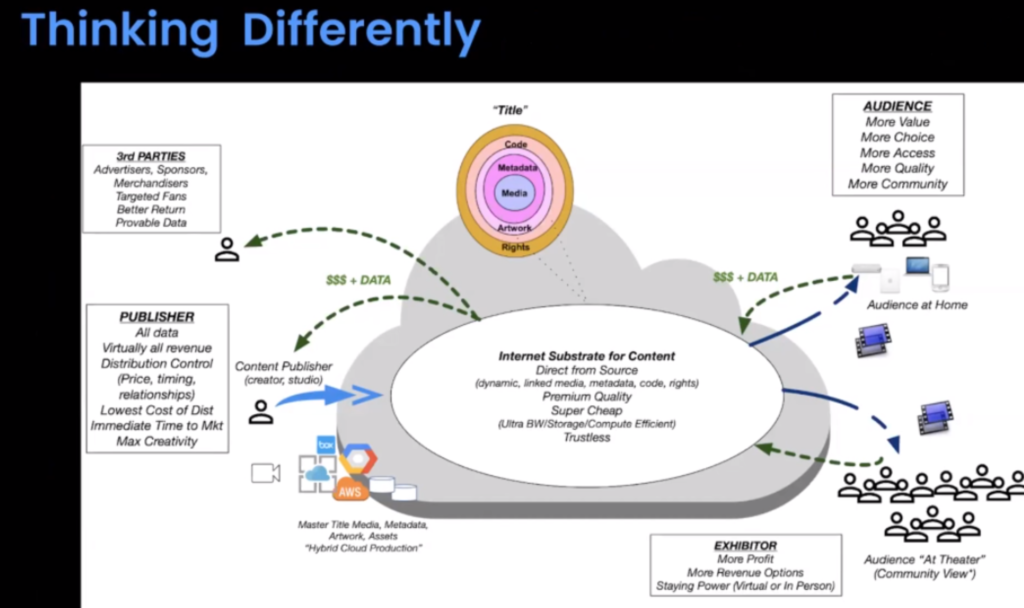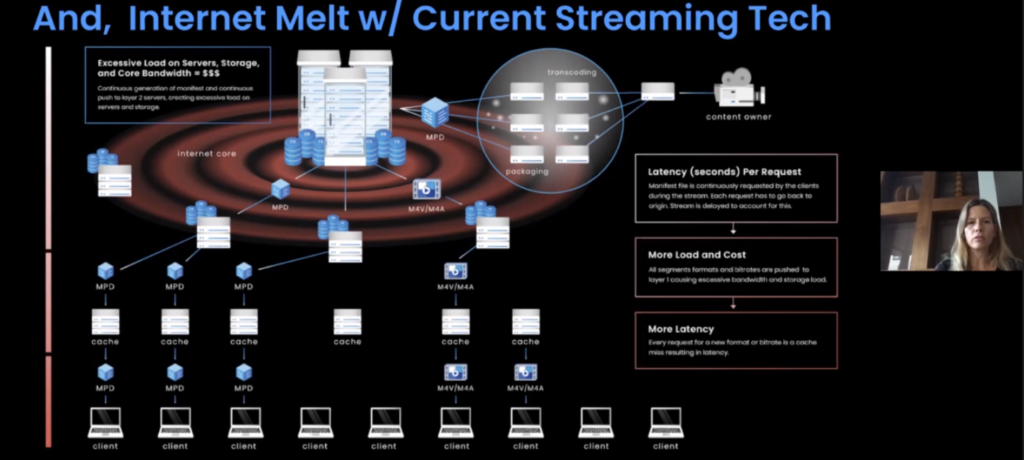
Eluvio CEO: Company’s Flexible Approach to Streaming Arrived Just in Time
Eluvio’s new supply chain approach for streaming and servicing film and TV catalogue content direct from their source assets, for sales, licensing and ticketed direct exhibition is a flexible solution that has arrived just in time – as the streaming of new film releases has become a necessary option for studios during the COVID-19 pandemic, according to Michelle Munson, CEO and co-founder of Eluvio.
The new blockchain-backed delivery option via the company’s Eluvio Content Fabric technology allows content providers to manage and distribute video directly from source as video on demand and live streaming, without using separate transcoding, content distribution or aggregation services, she said Nov. 5 during the Smart Content Summit EU event.
This “just-in-time, source-to-asset distribution” approach — recently used to stream private, global exhibitions of Bill & Ted Face the Music and The Wolf of Snow Hollow in 4K to browsers, connected TVs and mobile platforms — eliminates the need of delivery intermediaries and comes with individualised watermarking digital rights management (DRM), she pointed out during the Assets & Workflow breakout session “Just-in-time Asset to Exhibition for Premium Content.”
She started the presentation by presenting an image of a black swan because “2020 is nothing but” a black swan – random, dominant, “a time of large magnitude change and one that will probably never leave us,” she said.
 However, she pointed to another similar concept coined by black swan theorist Nassim Nicholas Taleb, antifragility, in which randomness like we’re experiencing right now is not only good, but actually essential to reveal what’s robust and lasting-gain from disorder. “Black swan events make systems no longer fragile,” she said.
However, she pointed to another similar concept coined by black swan theorist Nassim Nicholas Taleb, antifragility, in which randomness like we’re experiencing right now is not only good, but actually essential to reveal what’s robust and lasting-gain from disorder. “Black swan events make systems no longer fragile,” she said.
The rise of streaming video is “reshaping the industry,” she told viewers, noting theatres and the traditional means of distribution are “forever fragile or gone.”
There are advantages of digital distribution but “there are arguably quite a few downsides for both publishers and consumers” as well, she noted, briefly pointing to the pluses and minuses of digital distribution vs. traditional theatrical release windows.
Advantages of digital releases include: Exhibition venue flexibility; immediate time to release; more consistent revenue sharing to the distributor (which is 100% if the distributor owns the platform); reduced distribution costs; and increased digital re-monetisation, she noted.
However, the drawbacks of digital distribution are that it can be harder to reach a mass audience, there is lower average revenue per viewer, and traditional remerchandising is harder, according to the presentation slide she pointed to.
“On the publisher side, there’s a real question as to whether this is sustainable for all companies,” she said. One important question we must ask is whether all media and entertainment companies will have to be content and tech companies from now on, she noted.
Data is “more lucrative than the content itself” generally, she pointed out. Meanwhile, “Internet distribution as we all know has been challenged,” so thinking differently is important now.
One key issue today is that there are challenges to using traditional Content Delivery Network (CDN) infrastructure for low latency live streaming, she said.
So the key question is: “How might we go about this whole proposition differently?” she noted, adding: “What would be a highly efficient, just-in-time approach to media distribution?
 The first step to reconsider is “how we think of media and its representations,” she said, explaining: “Instead of thinking about the final representations as all being what we’re pushing around, especially in flat-file form, think of the media itself in not only a componentised way, but one where the essence and the metadata, the rendering proposition or the rendering code and then also the rights are all part of the media objects, and those are all linked together in a way that allows them to work together inherently as different output variants are built. And then we think about a different approach to getting this representation of media inside of this new substrate built as output from source.”
The first step to reconsider is “how we think of media and its representations,” she said, explaining: “Instead of thinking about the final representations as all being what we’re pushing around, especially in flat-file form, think of the media itself in not only a componentised way, but one where the essence and the metadata, the rendering proposition or the rendering code and then also the rights are all part of the media objects, and those are all linked together in a way that allows them to work together inherently as different output variants are built. And then we think about a different approach to getting this representation of media inside of this new substrate built as output from source.”
What we are talking about, she said, is “a new approach to what we traditionally call clouds and CDNs that allows us to take this componentised, if you will, object and be able to create output directly from it – from those linked components – [and] do it in a way that does not compromise the quality of video in broadcast live, linear or on demand distribution, which means it has to scale up to the highest resolutions, it has to work with good responsiveness globally [and] it also has to evolve as codecs evolve.”
The solution also “needs to be highly efficient – highly efficient in its use of bandwidth and storage so we’re not continuing to just pass files around through all these layers of infrastructure, and it’s not piecemeal – in other words, we don’t do piecemeal transcoding and distribution and watermarking and DRM but instead those become inherent, just-in-time properties of this very structure as a result of the intelligence of this layer,” she explained.
And then, last, the new approach “needs to be trustless – and trustless really refers to the approach to security” – meaning that “the infrastructure be able to serve media and content from multiple parties without having to be structured to do the right thing, which relies on the security model,” she said.
“If we had such an approach in technology, in a substrate that worked globally and we had a straightforward way that standard media becomes this kind of componentised link structure as it’s being managed and distributed then we open up a whole new set of properties,” she said.
Publishers would “have direct control… over how media is actually distributed, including things like windows, pricing, timing and also they benefit from low cost – low cost of distribution – and because of the just-in-time, flexible nature of this, they can also personalise the media,” she explained.
 Meanwhile, the audience “benefits on the other side with… more choice, better quality and more access,” she noted, adding: “The data, which is associated with the audience, because of who they are, flows inherently in a system like this directly back to the publisher and any third parties that they directly engage and isn’t lost in the fuzz of the intermediary system.”
Meanwhile, the audience “benefits on the other side with… more choice, better quality and more access,” she noted, adding: “The data, which is associated with the audience, because of who they are, flows inherently in a system like this directly back to the publisher and any third parties that they directly engage and isn’t lost in the fuzz of the intermediary system.”
Also, “because this is flexible – just in time – and, if you will, utilises sort of the best of the 3.0 Internet technology, it’s possible to have new business models with this that allow for exhibitors to potentially be part of the ecosystem whether the same output is being actually shown in a theatre, streamed directly or they’re participating virtually as part of the business model,” she pointed out.
And the solution Eluvio has developed that accomplishes all of this is the new, blockchain-backed delivery option via the company’s Eluvio Content Fabric technology, she said.
Click here to access the full presentation.
Smart Content Summit EU was produced by MESA and MESA Europe, in association with CDSA, HITS and the Smart Content Council, which meets regularly to share best practices, evaluate emerging technologies and collaborate to accelerate the pace of transformation in our industry. The summit is sponsored by ATMECS, Cognizant, Deluxe, Digital Nirvana, Éclair, Eluvio, EIDR, Iyuno Media Group, TransPerfect, NAGRA, Premiere Digital, Zixi, Whip Media Group, AppTek and EIDR.
